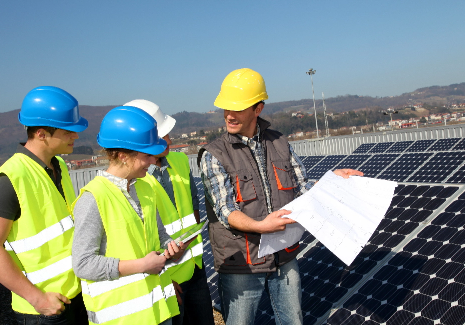North and South Carolina got more good news on the clean energy front earlier this year when they were among seven states awarded money in a new United States Department of Energy (DOE) program designed to improve planning, siting, and permitting processes for large-scale renewable energy facilities. The Carolinas will split $2 million to help streamline the permitting process by improving communications between power companies, developers, and community leaders.
Awards were provided through the DOE’s Renewable Energy Siting through Technical Engagement and Planning (R-STEP) program, which is part of the White House’s “Investing in America” agenda. In addition to the Carolinas, other states that received awards were Indiana, Iowa, Michigan, Mississippi, and Wisconsin.

Photo Courtesy NC Clean Energy Technology Center
According to a March 25 news release, six state-based projects will receive $10 million through R-STEP to develop and expand statewide initiatives.
They will provide expertise, training, and technical resources to local governments and communities as they plan for and evaluate large-scale renewable energy and storage projects.
WSOC-TV reported that the North Carolina Clean Energy Technology Center will collaborate with local stakeholders, developers, utilities, landowners, and governments to create an online assistance and education hub as part of the program.
According to Steve Kalland, executive director of the NC State University Energy Collaborative, community input plays a major role in the permitting process. With the DOE funding, the hub aims to address common concerns and questions in a single, accessible place.

Photo Courtesy NC State Energy Collaborative
“A lot of these permitting processes around the country are asking the same questions, and so if you add it up and you add up all of the delays that are happening in all of the different proceedings, it’s a lot of delay,” Kalland told WSOC. “If we can answer some of these questions one time and make the information available to everybody, hopefully, that will squeeze a lot of time out of the overall picture of permitting.”
One focus will be on conducting surveys and meeting with landowners, developers, and other stakeholders to learn more about common concerns.
“We’re going to go through the literature and figure out what’s already been answered and identify the questions where there’s still research needed,” Kalland said.
According to the DOE, R-STEP’s primary mission is to help “communities better plan for and meaningfully engage in the development of large-scale renewable energy and energy storage projects.” The goal is to accelerate the deployment of renewable power by aiding in “the establishment of more predictable, community-oriented, and science-based” siting processes for developers and permitting authorities.

Photo Courtesy NC Clean Energy Technology Center
The DOE describes renewable energy siting as a “complex series of decision-making processes and actions that determine the location and design of new wind, solar, storage, or other renewable energy facilities.”
State and local governments play “critical roles” in expediting and approving large-scale clean energy facilities. However, the DOE noted that they might not always have the resources, time, or expertise to proactively plan for future deployment of these facilities or to address siting barriers. R-STEP aims to provide those resources and expertise.
The work is especially important in North Carolina, where leaders like U.S. Senator Thom Tillis and Governor Roy Cooper have led efforts to ramp up the state’s offshore wind industry.
“I want more of these energy solutions to be based in North Carolina and exported throughout the world and the United States,” shared Sen. Tillis during an event hosted by Consensus Digital Media earlier this year.
As The Business Download previously reported, Cooper signed Executive Order No. 218 in 2021 that established a pair of offshore wind development goals: 2.8 gigawatts (GW) off the shoreline by 2030 and 8 GW by 2040. Cooper’s office estimates that achieving these goals would power about 2.3 million homes statewide by 2040 and create thousands of clean energy jobs.





